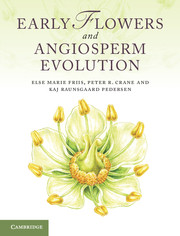Book contents
- Frontmatter
- Contents
- Preface
- 1 Introduction to angiosperms
- 2 The nature of the angiosperm fossil record
- 3 The environmental context of early angiosperm evolution
- 4 Stratigraphic framework and key areas for Cretaceous angiosperms
- 5 Angiosperms in context: extant and fossil seed plants
- 6 Origin and age of angiosperms
- 7 Phylogenetic framework and the assignment of fossils to extant groups
- 8 Fossils near the base of the angiosperm tree
- 9 Early fossil angiosperms of uncertain relationships
- 10 Early fossils of eumagnoliids
- 11 Fossils of monocots
- 12 Fossils of eudicots: early-diverging groups
- 13 Fossils of core eudicots: basal lineages
- 14 Fossils of core eudicots: rosids
- 15 Early fossils of eudicots: asterids
- 16 Patterns of structural diversification in angiosperm reproductive organs
- 17 History and evolution of pollination in angiosperms
- 18 History and evolution of dispersal in angiosperms
- 19 Vegetational context of early angiosperm diversification
- 20 The accumulation of angiosperm diversity
- References
- Index
8 - Fossils near the base of the angiosperm tree
Published online by Cambridge University Press: 07 September 2011
- Frontmatter
- Contents
- Preface
- 1 Introduction to angiosperms
- 2 The nature of the angiosperm fossil record
- 3 The environmental context of early angiosperm evolution
- 4 Stratigraphic framework and key areas for Cretaceous angiosperms
- 5 Angiosperms in context: extant and fossil seed plants
- 6 Origin and age of angiosperms
- 7 Phylogenetic framework and the assignment of fossils to extant groups
- 8 Fossils near the base of the angiosperm tree
- 9 Early fossil angiosperms of uncertain relationships
- 10 Early fossils of eumagnoliids
- 11 Fossils of monocots
- 12 Fossils of eudicots: early-diverging groups
- 13 Fossils of core eudicots: basal lineages
- 14 Fossils of core eudicots: rosids
- 15 Early fossils of eudicots: asterids
- 16 Patterns of structural diversification in angiosperm reproductive organs
- 17 History and evolution of pollination in angiosperms
- 18 History and evolution of dispersal in angiosperms
- 19 Vegetational context of early angiosperm diversification
- 20 The accumulation of angiosperm diversity
- References
- Index
Summary
In this chapter we consider fossils that appear related to the extant ANITA lineages: Amborellaceae, Nymphaeales (Hydatellaceae, Cabombaceae, Nymphaeaceae), and Austrobaileyales (Austrobaileyaceae, Schisandraceae including Illiciaceae, Trimeniaceae) (Figure 8.1). These three lineages are recognised in all recent phylogenetic analyses as the first to diverge from the main line of angiosperm evolution and form a series of successive sister groups to all other angiosperms (Chapter 7). We also consider the fossil history of Chloranthaceae and Ceratophyllaceae. Both are usually resolved as separate lineages that diverge above the level of Austrobaileyales, but their position with respect to eumagnoliids, monocots and eudicots is not fully secure. There is some indication that Chloranthaceae may be the sister group to eumagnoliids, while Ceratophyllum may be the sister group to eudicots (Moore et al., 2007). In Chapter 9 we describe fossil reproductive structures, mainly from the Early Cretaceous, that may also be relevant to this initial phase of angiosperm diversification, but that cannot be assigned to any extant family or order with the information currently available.
Early-diverging angiosperm lineages at the ANITA grade
The known fossil record of plants related to the ANITA lineages, as well as to Chloranthaceae, continues to increase rapidly. The relevant fossil material includes leaf compressions and impressions and a variety of dispersed pollen, as well as flowers and floral organs. Some of these fossils can be assigned reliably to extant orders, families or even genera. Ceratophyllaceae also have an extensive fossil record, but are most common in Cenozoic floras. There are only a few, uncertain records of Ceratophyllaceae from the Cretaceous.
- Type
- Chapter
- Information
- Early Flowers and Angiosperm Evolution , pp. 169 - 188Publisher: Cambridge University PressPrint publication year: 2011



